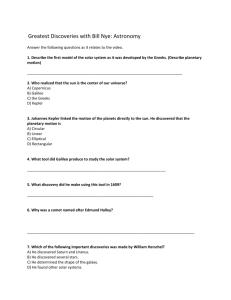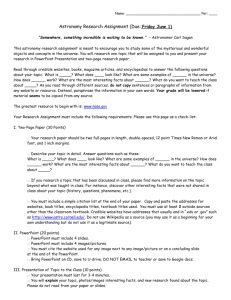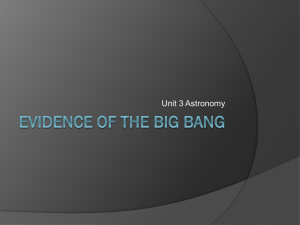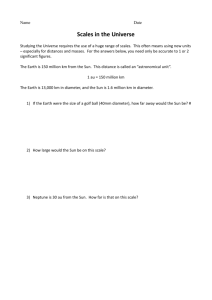Lecture 1 - Department of Physics and Astronomy
advertisement
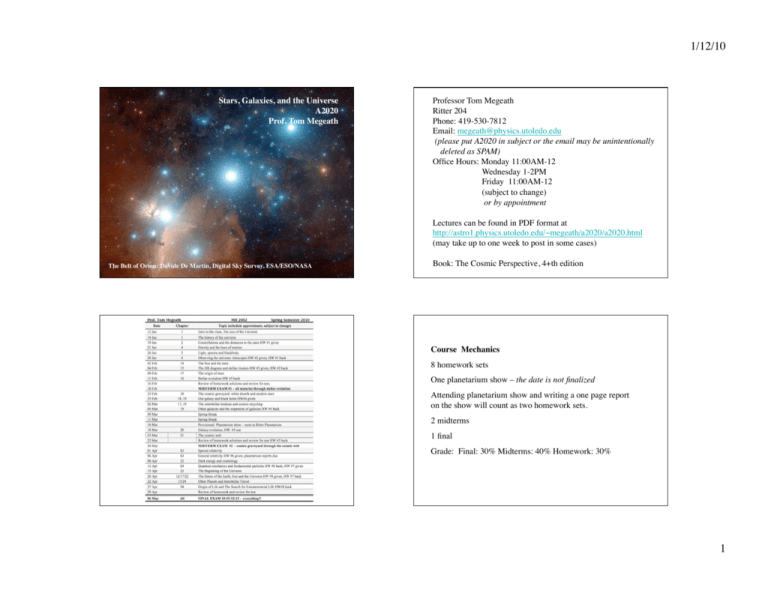
1/12/10 Stars, Galaxies, and the Universe A2020 Prof. Tom Megeath Professor Tom Megeath Ritter 204 Phone: 419-530-7812 Email: megeath@physics.utoledo.edu (please put A2020 in subject or the email may be unintentionally deleted as SPAM) Office Hours: Monday 11:00AM-12 Wednesday 1-2PM Friday 11:00AM-12 (subject to change) or by appointment Lectures can be found in PDF format at http://astro1.physics.utoledo.edu/~megeath/a2020/a2020.html (may take up to one week to post in some cases) The Belt of Orion: Davide De Martin, Digital Sky Survey, ESA/ESO/NASA Book: The Cosmic Perspective, 4+th edition Course Mechanics 8 homework sets One planetarium show – the date is not finalized Attending planetarium show and writing a one page report on the show will count as two homework sets. 2 midterms 1 final Grade: Final: 30% Midterms: 40% Homework: 30% 1 1/12/10 Policy on math in Astronomy 2010 Scientific Notation You are expected in this class: 10 = 101 100 = 102 1000 = 103 210,000 = 2.1 x 105 1. Be capable of high school level geometry and algebra 2. Know the metric system 3. Be able to use scientific notation These skill will be needed to answer some of the midterm questions. This is important in astronomy. For example, the mass of the Sun is: 1,988,920,000,000,000,000,000,000,000,000,000 gm = 1.988920 x 1033 gm One year is 3.1557 x 107 seconds or approximately = π x 107 seconds The Metric System is used by all scientist without exception Distance: 1 mile = 1.6 km 1 foot = 0.3 m 1 inch = 2.54 cm 100 cm = 1m 1000 m = 1 km 105 cm = 1 km Mass: 454 gm = 1 lb 1000 gm = 1 kg Volume: 1 gallon = 3.79 l (liter) 1000 ml = 1 l Temperature Fahrenheit - proposed by Gabriel Fahrenheit in 1724 no one is certain how he came up with the scale Celsius (Metric) 0 C = freezing point of water = 32 F 100 C = boiling point = 212 F Kelvin 273 K = 0 C 273 K = freezing point of water 373 K = boiling point of water 0 K is absolute zero, the lowest temperature possible. Astronomers use the Kelvin scale. 2 1/12/10 Thermal Energy: Temperature Scales Special Astronomy Units Solar Mass = mass of the sun = 2 x 1033 grams Jupiter Mass = 0.001 solar masses = 2 x 1030 grams Earth Mass = 0.003 Jupiter masses = 6 x 1027 Astronomical Unit = distance from the Earth to the Sun Light Year = distance light travels in 1 yr = 9.4 x 1017 cm Parsec = 3.26 light years = 3.08 x 1018 cm Factoid: the nearest star is 1.30 pc or 4.22 light years Measuring Distances with a Beam of Light Orders of Magnitude The Speed of Light in a vacuum: Scientist use the phrase “order of magnitude” to indicate when something is ten times bigger, smaller, denser, older, younger, etc….. than something else. For example: Milky Way Galaxy is nine orders of magnitude bigger than our solar system 299,792.458 km/s (kilometers per second) The speed of light is a universal constant, it does not change over time or from place to place. Thought Experiment: imagine two teams of scientist measuring the speed of a beam of light. One team measures the speed from a ground. The second team measures the speed from a fast moving airplane following the light beam. Do the two measurements differ? 3 1/12/10 Measuring Distances on a Cosmic Scale Imagine shining a laser beam into space Since the speed of light is constant, it makes a convenient means for measuring distances. Destination Light travel time Distance to the nearest star: Moon 1 second Kilometers: 4 x 1013 km Sun 8 minutes Sirius 8 years Light Years: 4.2 ly Andromeda Galaxy 2.5 million years Parsecs: 1.29 pc . (I will explain why astronomers use parsecs in lecture 3) Starting Point: The Sun 8 Minutes Home Sweet Home Distance from Sun 1.0AU Radius:6378 Km Mass: 1. Earth Masses Temperature: 290 K Orbital Period: 365.25 Days One Moon Radius: 696000 Km 108 Earth Radii Mass: 3.33 x 105 Earth Masses Surface Temperature: 6000 K 4 1/12/10 The Outer Solar System 40 minutes - the planet Jupiter 4-12 Years: Nearby Stars in the Neighborhood Not all stars are the same 4 hours - the dwarf planet Pluto 13 hours - Sedna (most distant known object) 1.59 solar masses 1.56 solar F5V 12 light years 2 solar masses Out of the 25 nearest stars: Only two more massive than the sun Nine are stellar system with two to three stars orbiting each other 57 days - the Oort cloud. 5000 Years: The Inner Milky Way Galaxy The Milky Way in Visible Light View from the Earth: Edge On 5 1/12/10 The Milky Way in the Infrared Our Galaxy: The Milky Way For Light Beam to go to center from Earth: 25,500 years For light beam to traverse; Galaxy: 100,000 years View from the Earth: Edge On The Center of Our Galaxy (25,500 Years) Artist Conception of view from above the Milky Way 2.5 Million Years: The Nearest Galaxy Andromeda Spitzer space telescope, infrared image, S. Stolovy 6 1/12/10 1-10 Myr: The Local Group of Galaxies 50 Million Years: Sombrero Galaxy The Hubble Space Telescope Ultra Deep Field 500 Myr: Hercules Clusters of Galaxies 7 1/12/10 The Hubble Space Telescope Ultra-Deep Field (out to 12.7 billion years) How big is the Universe? • The Milky Way is one of about 100 billion galaxies. • 1011 stars/galaxy x 1011 galaxies = 1022 stars As many stars as grains of (dry) sand on all Earth’s beaches… If you had to write your address to an alien somewhere else in the Universe, what would you put? Your Cosmic Address Earth The Solar System The Milky Way Galaxy The Local Group The Universe 8 1/12/10 How far do we travel every day? Cosmic Motion The universe is in constant motion, for example: From rotation or Earth: 29,000 km How fast are we moving: Rotation of the Earth: 1200 km/hr Earth going around Sun: 100,000 km/hr From orbit of Earth around Sun: 2.4 million km The Solar System going around the Galaxy: 600,000 km/hr Our Galaxy moving in the Local Group: 300,000 km/hr From orbit of Sun around Galaxy: 14 million km The Universe is Dynamic! Galaxies in the Ultra Deep Field Our galaxy moving toward the Virgo cluster: 1x106 km/hr The Universe is Dynamic: Interacting Galaxies The Antenna: 20 Million Light Year 9 1/12/10 The Universe is Dynamic: Interacting Galaxies The Universe is Dynamic: Expanding Universe http://www.einstein-online.info/en/elementary/cosmology/expansion/index.html http://www.cita.utoronto.ca/~dubinski/antennae The dynamic events occur over millions and billions of years? How do we study the dynamic universe when things change so slowly? Answer 1: Telescopes are Time Machines When you look at an object 1 light away, you are looking at what it looked like 1 year ago. When you look at an object 1 million light years away, you are looking at it 1 million years ago. The universe is thought to be 13.66 billion years old, so when you look back 12.7 billion years - are you looking back to a time when the universe was “young”. Cosmic evolution can be studied by looking at more and more distant objects. 10 1/12/10 If the Sun suddenly stopped emitting light, how long before we would know it? a. Instantaneous b. 8 minutes c. A few days d. One year Cosmic Evolution How far away is the light emitted by our Sun from the Jurassic time of the dinosaurs (150 million years ago)? a. In our solar system b. In our galaxy c. In the Local Group d. Beyond the Local Group 400,000 Years after the Beginning of the Universe 11 1/12/10 Answer 2: By Observing Objects at Different Stages of Evolution Young star (pre-main sequence) Our sun (main sequence star) Answer 3: By using physics Planetary nebula (dying star) Summary Measuring distances by travel times of light. Traveling on a ray of light (know the relative sizes of things!) Your cosmic address The moving cosmos The dynamic cosmos 12

